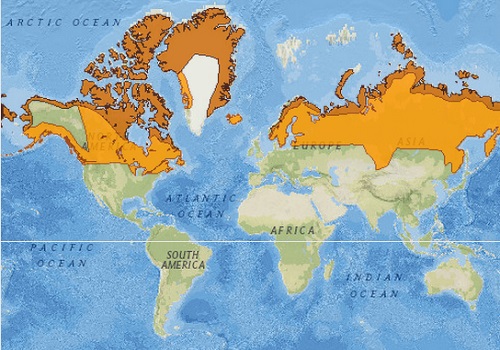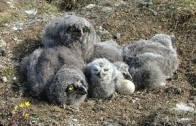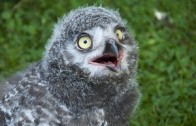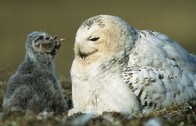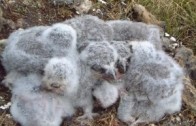Conservation Status
- The snowy owl (Bobus scandiacus) has a wide distribution and healthy population numbers, though its trend is declining. According to the IUCN its global population is estimated at more than 300,000 individuals.
- It does not meet the criteria for Vulnerable and it is listed as Least Concern by the IUCN Red List of Endangered Species.
- Snowy owls are protected birds under the U.S. Migratory Bird Act.
Taxonomy
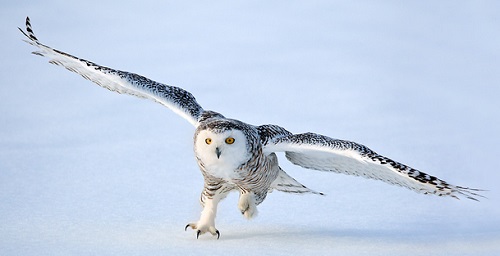
A female snowy owl in the Canadian tundra. This species is listed as Least Concern by the IUCN Red List.
- Kingdom: Animalia
- Phylum: Chordata
- Class: Aves
- Order: Strigiformes
- Family: Strigidae
- Genus: Bubo
- Species: Bubo scandiacus
0
0
Name
- Common name: Snowy owl, Arctic owl, Great white owl.
- Scientific name: Its classification is debated between Bubo scandiacus and Nyctea scandiaca.
Physical Features
- Females are larger than males.
- Most adult males have pure white feathers. Females have white feathers with brown barring and spots.
- During their first year males and females have darker feathers. Young females appear grey while young males look like adult females.
- Their coloration provides camouflage against predators.
- Their bodies are insulated by a layer of down and thick feathering that cover the entire body including toes.
- Snowy owls have yellow eyes which are surrounded by a layer or of disks made from stiff feathers. These feathers reflect the sound that bounces to their ears. Its developed hearing helps detect prey in darkness.
- Their eyes are permanently looking forward. When looking to their sides they swivel their heads 270 degrees.
Size and weight
- Snowy owls have a wingspan of almost 5 ft or 1.5 m.
- Their length ranges from 20 to 28 in or 52 to 71 cm.
- The average weight of a female is 5 lb or 2.3 kg. The average weight of a male is 4 lb or 1.8kg.
- They are the heaviest of the owl species.
Habitat and Distribution
- During summer snowy owls have a circumpolar distribution along the Arctic Circle in the northernmost areas of Alaska, Canada, Greenland, northern Scandinavia and Eurasia, to the north of 60˚latitude. Here its habitat consists of Arctic tundra.
- During winter those that migrate go south to the southern provinces of Canada, northern half of the USA and northern Eurasia
- Snowy owls are irruptive meaning that some migrate south while others stay in the Arctic. Its migration is highly variable. Some year populations migrate as far south as the state of Florida and Texas in the USA, southern Russia and northern China.
- These birds like treeless open spaces where they can have a good view and survey the surrounding area.
Behavior
- Snowy owls are diurnal or active during the day, all other species of owls that are nocturnal.
- These birds are shy and solitary unless is breeding season.
- They have irruptive or irregular migration. In some years populations stay in the Arctic all year round. In other years they usually migrate south during winter. Some snowy owls migrate from Russia to Canada.
- Males are territorial and can become aggressive if another male invades its territory. They vocalize and show body postures when showing aggression.
- Snowy owls are very agile. Once it eyes its prey it will dive bomb from above and snatch it on the ground or in the air.
- They can sit for hours in the same spot.
Reproduction
- Breeding occurs in winter from about February to March.
- Nests are built in the brush in the Arctic tundra.
- Clutch size is between 3 to 11 eggs which are laid over the course of several days. Eggs hatch after 5 weeks. Clutch size is directly correlated with fluctuations in the lemming population as it is its primary source of food.
- The male provides the female with food while incubating the eggs.
- Chicks are born usually in July at intervals of 48 hours.
- Both parents provide parental care and protect their young against predators.
Diet
- Snowy owls are opportunistic eaters. They eat a wide variety of small mammals such as arctic hare, rats, squirrels, rabbits, moles and muskrats but lemmings are their primary prey. They also feed from birds such as ptarmigans, ducks and shorebirds among others.
- They swallow their prey whole and regurgitate after 18 to 24 hours of feeding.
Life Expectancy
- In the wild they are expected to live up to 9.4 years.
- In captivity the maximum longevity is 28 years.
Threats
- Snowy owls have few natural predators. Eggs and chicks are at danger of predation by arctic foxes and other birds.
- Human activities such as construction of power lines, wire fences and car collisions are causes of mortality.
- Its population follows the cycle of its main prey, lemmings.
Fun facts about snowy owls
- The snowy owl has forward directed eyes which do not move in their sockets. When looking from side to side the snowy owl has to swivel its head 270 degrees.
- Their visual fields overlap widely giving them a binocular vision.
- It is the official bird of Quebec.
- Their favorite food is lemmings, they eat more than 1,600 of them a year.
- In 2014 the Canadian Mint issued a $50 silver coin snowy owl.
See also
Northern spotted owl
References and further research
University of Michigan Museum of Zoology – Nyctea scandiaca, snowy owl
The Animal Aging and Longevity Database – An age entry for Bubos scandiacus
Cornell Lab of Ornitology – Snowy owls
Nature Conservancy Canada – Snowy owls
IUCN Red List or Threatened Species – Bubos scandiacus
Environment Canada – Snowy owls

